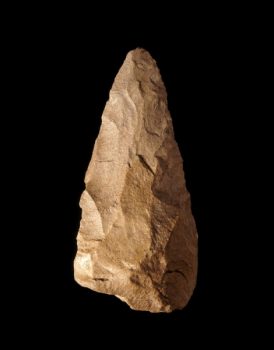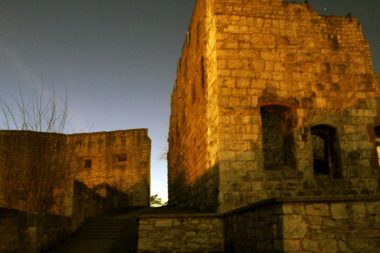Heidenheim an der Brenz is a town in southwest Germany in state Baden-Württemberg. History of this town can be traced back to a distant human past but its true development begins from the Middle Ages. The etymology of the Heidenheim still not clear, coat of arms from 1486., showing Heiden (heathen) and the symbol (head of man) on the coat of arms has been depicted as founder of the city, Heido.
Heidenheim an der Brenz, prehistoric and ancient time
The territory of today’s Heidenheim an der Brenz was firstly inhabited by Neanderthals (Homo erectus) who were associated within the prehistoric culture of the Young Acheulean (Acheuléen) about 70.000-50.000 years before present. The evidence of their presence can be found around today’s Heidenschmiede, an important archeological site whose findings dating back to the middle Paleolithic. Local Swabian historian Hermann David Mohn (1896-†1958) was one of the first researchers’ who excavated this area. From the time of the first excavations until today, several thousand different prehistoric artifacts were discovered around the Heidenschmeide especially at the Lonetal Valley.
The first excavations at the Lonetal Valley dated back in 1861 by geologist and paleontologist Oskar Fraas and later Robert Wetzel, Otto Völzing, Joachim Hahn, Nicholas Conrad. Most famous caves for researchers in the Lonetal Valley was the “Bears’ Cave”, “Hohlenstein Stadel”, “Bockstein”. Excavated findings also showed that prehistoric humans mixed with different cultural groups such as Moustérien and Beuronien. First settlements were built in Iron Age between 1300 and 800 BC. At the end of the 85 AD an elite roman formation Ala Secunda Flavia pia fidelis milliaria setup their fortress at the location of today’s Heidenheim. This fortress in the roman roads map Tabula Peutingeriana (or The Peuntinger map) was marked as Aquileia.



The construction of a fortress in this area was important for Romans because its purpose was to protect borders (limes) of the Roman Empire from the eventual attacks of Celts. This fortress together with the settlement was spread around 20 hectares. During the time, this fortress was not only served for military purposes. After 150 AD fortress became the center of civil government because strategic positions were changed for Romans. New Limes (borders) was established about 20 kilometers away from the currently position. The confederation of Germanic tribes Allemani (Swabians) between 233 and 260 AD were usually attacked Romans fortifications at the borders in the Gaul. Finally, in 260 AD Allemani were managed to conquer the fortifications and expelled the roman troops around the territory of today’s Heidenheim. After those events, historical sources about territory of Heidenheim an der Brenz during the period of the Roman Empire are very scarce.
Hellenstein Castle, medieval period
The first mention of Heidenheim an der Brenz some historians putted in 8 century AD, but in historical sources Heidenheim was mention in the context of establishing double Anglo-Saxon monastery (Kloster Heidenheim) founded by Wilibald (Bishop of Eichstadt). This Monastery is approximately 70 kilometers (44 miles) away from the Heidenheim an der Brenz. Fortress of the Heidenheim an der Brenz or Hellenstein was built between 1120 and 1130 by Hellenstein family member probably Gozbert de Hellensteine. By the aspect of the territory organization its belong to Duchy of Swabia. Frederick I Barbarossa, Holy Roman Emperor appointed the noble Degenhard von Hellenstein as Prokurator (Governor) for the Duchy of Swabia. Hellenstein Castle was in possession by Hellenstein family by the end of 1273 when the last male successor died.



In next 80 years several owners had in possession Hellenstein Castle. Ludwig IV of Spitzenburg (later Ludwing I of Helfenstein) expanded his territory to Swabian Albs, Heidenheim an der Brenz, Ulm and Danube River valley near Sigmaringen. Officially Hellenstein was under the rule of Helfenstein family from 1351, but at that time Helfenstein family struggled within dynastic confrontations. Urlich VI divided House of Helfenstein into two branches Wiesensteiger and Blaubeurer. The Blaubeurer branch had in their possession a very short time territory of Heidenheim. In 1480 Blaubeuer branch lost many territories including Hellenstein which has become property of the House of Württemberg but officially their property was recognized by Bavaria in 1504. On 5th August 1530 Hellenstein was burn out and several years later Duke Ulrich of Württemberg (1487-1550) ordered a reconstruction who lasted from 1537 to 1544. Only so-called Knight’s Hall was not part of the reconstruction of the city and it can be still seen today in original shape. A new reconstruction with new walls and buildings including Fruchtkasten (granary) and church has begun during the reign of Friedrich I of Württemberg (1557-1608). Italian-Duch architect and painter Friedrich Sustris in 1593, was engaged to decorate walls and tower. Friedrich I also ordered the construction of a new water supply which was finished after his dead 1611. The main architect for this project was Heinrich Schichkardt from Stuttgart. Several years later, broke out one of the most destructive wars in Europe, so called Thirty Years’ War (1618-1648) and its main actors were almost all continental European states. The war began as a conflict between Protestants and Catholics, but turned into a general war that engulfed most of Europe.
During the war in 1634 Hellenstein was again damaged and water supply system was destroyed. After the end of Thirty Years’ War completely new water system 78 meters deep was built between 1666 and 1670 in the southern part of the city. This water system was known according to legend as ”Kindlesbrunnen” or baby fountain and today is still in good shape. During the War of the Spanish Succession (1701–1714) the French occupied the castle with about 10,000 soldiers, the conquest has been stopped because they estimated that they might have too much military losses. In 1805, during his campaign Napoleon Bonaparte also visited Hellenstein castle but from the first half of the 19th century medieval Hellenstein started to lose its purpose. Urban development began at beneath of the fortress and the iron and textile industry began to grow to.
Sources:
- Landesmuseum Württemberg (2012): LegendäreMeisterWerke. Kulturgeschichte(n) aus Württemberg. Begleitband zur Dauerausstellung. Stuttgart, P. 23.
- Peters, E. (1931): Die Heidenschmiede in Heidenheim. In: Fundberichte Baden-Württemberg, NF VI, P. 1-36.
- Württembergisches Landesmuseum, Keefer, Erwin (1993): Steinzeit. Stuttgart, P. 18 f.
- Württembergisches Landesmuseum, Schröder, Heike (Red.) (1998): Kunst im Alten Schloß. Stuttgart, P. 20
- Stepahine Hollis, Anglo-Saxon Women and the Church: Sharing a Common Fate, Great Britain 1992.
